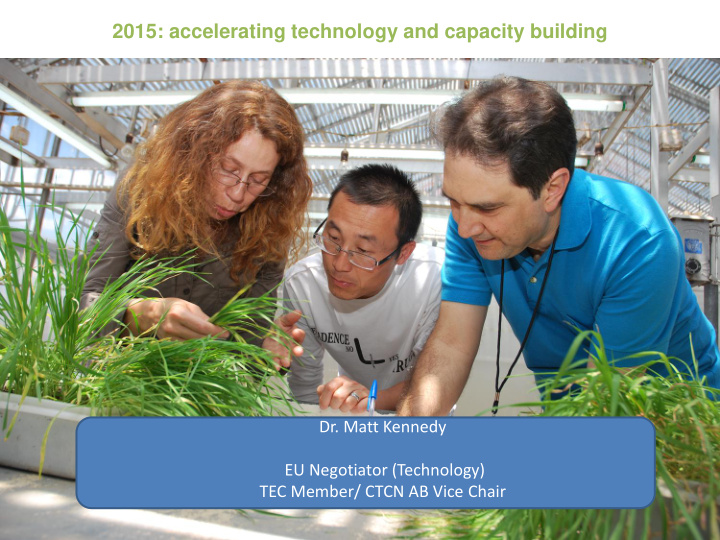



2015: accelerating technology and capacity building Dr. Matt Kennedy EU Negotiator (Technology) TEC Member/ CTCN AB Vice Chair
1. Stimulation of TT What is the most effective way that the 2015 agreement could stimulate the development, diffusion, and transfer of climate-related technologies, and strengthen climate-relevant capacity building? - Through the Technology Mechanism (TM), and stimulated by CTCN requests - Fortify the role of TM and focus TT-related efforts under the Convention - Technology is both a cross-cutting priority and one element of the proposed agreement with Broad support among Parties for anchoring the TM in the 2015 Agreement. Technology is a pillar of the UNFCCC negotiations. • Technology for achieving an emission pathway consistent with limiting the global average temperature increase to below 2 °C or 1.5 °C above pre- industrial levels and considerably improving the adaptation capacity of developing countries.
UNFCCC: agreed on the Technology Mechanism in December 2010 to support action on technology development and transfer for mitigation and adaptation Objective: enhance action on the development and transfer of technology for action on climate change • Cancun Agreements established a Technology Mechanism, consisting of: o ( TEC ) as the policy and strategy arm of the Mechanism o ( CTCN ) to provide direct support to technology actions in developing countries to address climate change 3
Stimulation of TT: How? Process TT Conten t Lima 2014: TEC & Technology - shape of Elements: TNAs, PSP, INDCs information, Enabling. Durban - draft Environments, Finance 2011: launch elements of of Durban the 2015 "Mandate" Agreement 2015 Design of the elements Agreement (addressing mitigation, adaptation, support, transparency) Warsaw Paris 2015 : 2013: call for adoption of intended the new TM-FM-CB ( “Climate nationally Agreement Resilience and determined Sustainable contributions Development (INDCs) by Mechanism” ) March 2015
CTCN Mandate CTCN mission is “Stimulating technology cooperation and enhance the development and transfer of technologies to developing country Parties at their request”.. helps developing countries to link their needs with practical advice how to implement mitigation and adaptation projects. ...
CTCN Services and Structure Services: 1. Technical assistance to developing countries 2. Knowledge sharing and training 3. Fostering collaboration on climate technologies (including linking climate technology projects with financing opportunity”) Structure: CTCN hosted by UNEP in collaboration with UNIDO and supported by 11 partner institutions with expertise in climate technologies
CTCN Consortium 7
National Designated Entities (NDEs) 107 NDEs have been selected by their countries as of 24 February 2015
CTCN Technical Assistance Provided: • To developing countries upon their request • Free of charge (value up to 250,000 USD) • E xpertise that is both state of the art and locally relevant • To academic, public, NGO, or private entities • For a broad range of adaptation and mitigation technologies At all stages of the technology cycle : • From identification of needs; • policy assessments; • selection and piloting technology solutions; • to assistance that supports technology customization and widespread deployment
CTCN Technical Assistance
Colombia: Energy efficiency and renewable energy Applicant: Colombian Ministry of Environment and Sustainable Development Request: Monitoring and evaluation of national energy efficiency and renewable energy strategies against national targets Objective: To maintain Colombia’s economic growth while reducing greenhouse gas emissions in productive sectors Assistance: • Assessment of incentives for energy efficiency (EE) and non-conventional energy sources (NCES) focused on fiscal incentives • Design of a monitoring and evaluation mechanism to assess benefits derived and impact of national incentives Response Expert Team: • Fundación Bariloche (Buenos Aires, Argentina) • National Renewable Energy Laboratories – NREL (Colorado, USA)
Iran: Photovoltaic Solar Cell Design & Manufacturing Applicant: Iranian Ministry of Energy Request: Guidance on the construction of a medium sized (1-5 MWp) solar photovoltaic plant to serve as a pilot project for the country Objective: To learn how to independently design, produce and quality control the production of photovoltaic solar modules Assistance: • Inventory of needs and requirements for PV pilot line and gap analysis • preliminary design based on gap analysis • financial analysis for budgeting purposes Response Expert Team: • The Energy and Resources Institute - TERI (New Delhi, India) • The Energy Research Centre of the Netherlands -ECN (Petten, The Netherlands) • UNIDO Representative (Iran)
2. Global goals What role could global goals play in this regard, and how could they be articulated to effectively meet national needs and priorities?
2. Global goals Goals should rather be linked to mitigation INDCs , rather than something that complicates MRV systems If a country declares certain level of emission cuts, this can be/needs to be translated into specific technological requirements (e.g. by help of TNA) Individual Parties need to play active roles in this, and it would be difficult to plan/prescribe the "best" approach on a global scale. Technology transfer translates into financial support so funding (goals) for technology projects is the best way to measure the success
Update by Mr. Fred Onduri matthew.kennedy@seai.ie CTCN Advisory Board Chair For more information on TT, please visit: http://unfccc.int/ttclear/pages/home.html http://ctc-n.org
Funds Committed by Donor
Climate Technology Network Members
Recommend
More recommend